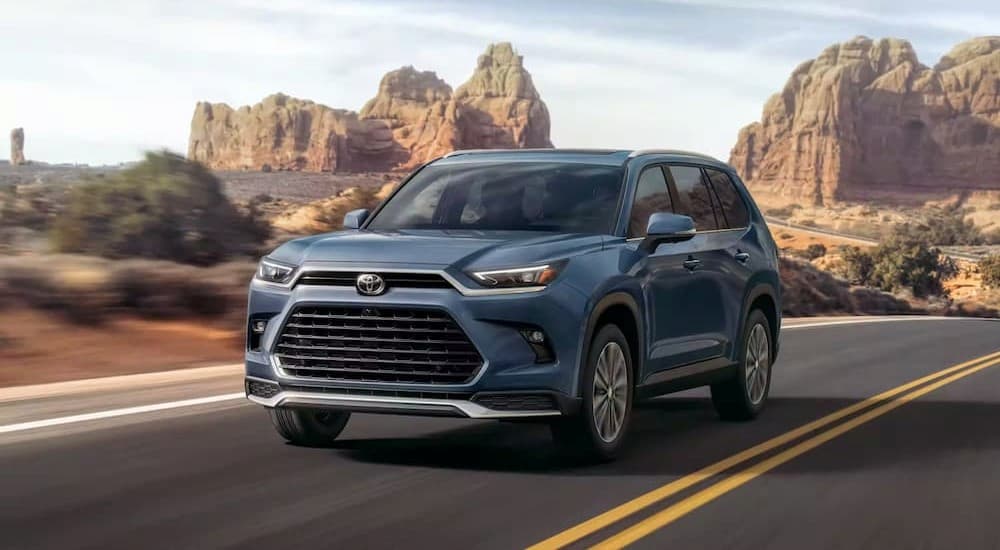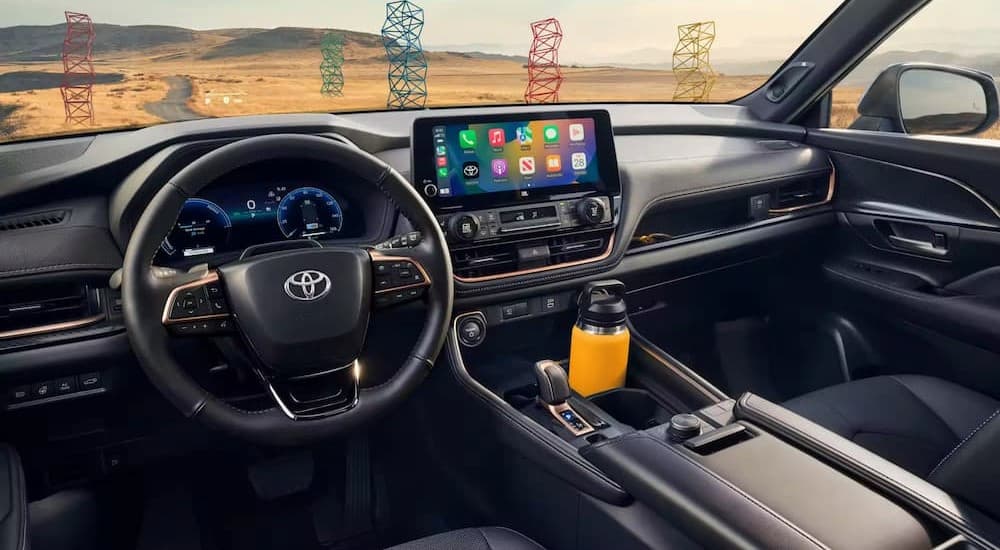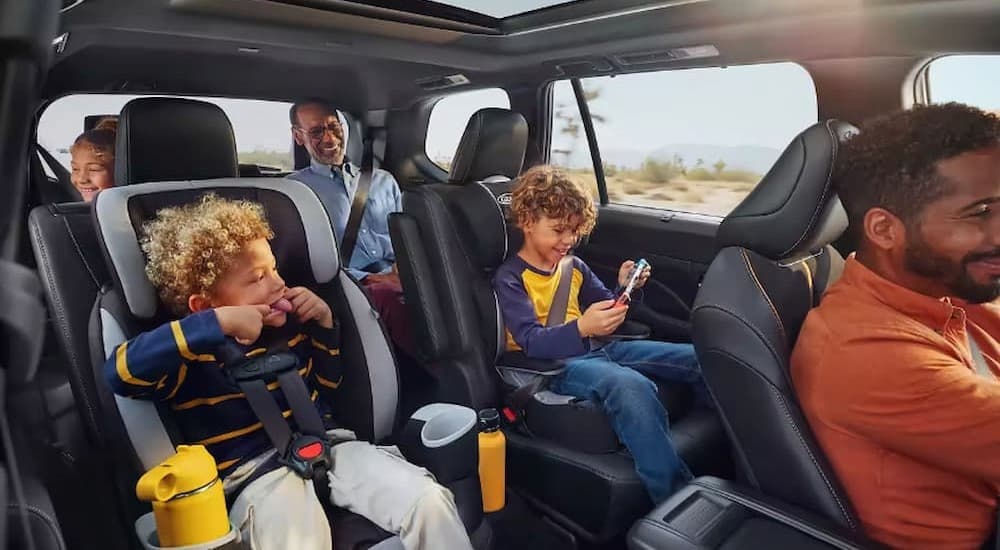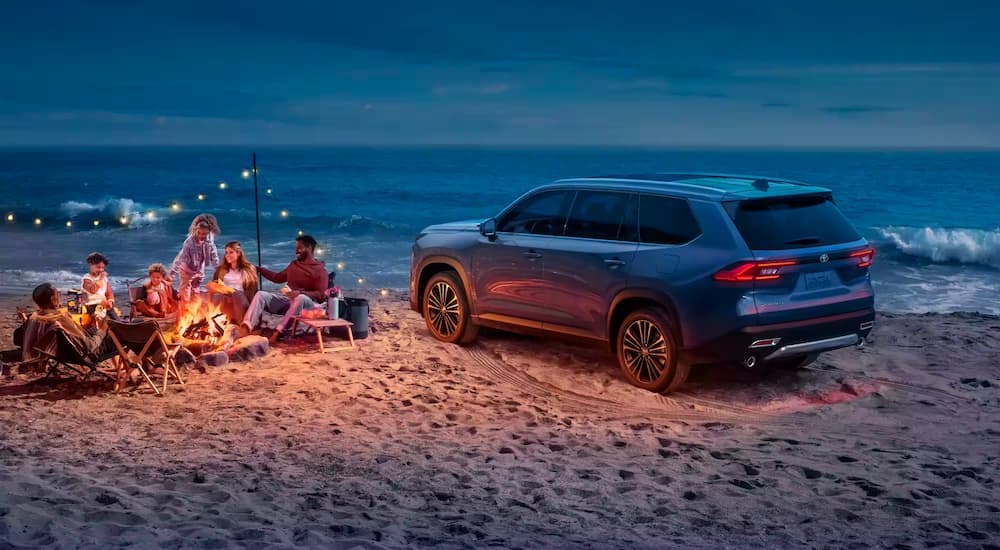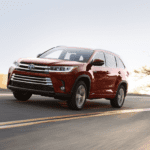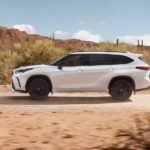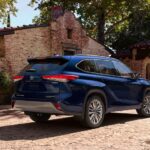For some parents, minivan ownership requires handing over their cool cards and surrendering to a cringe-worthy few years of carting the kids around in a cliché. Still, the thought of pulling the trigger on a massive gas-guzzling SUV sends equally unpleasant shivers down their spines. It’s a paradox, but one that isn’t without a solution, thanks to Toyota. For buyers looking to retain their pre-kid image without sacrificing practicality, consider the all-new 2024 Toyota Grand Highlander.
A new entrant into the large SUV category, the Grand Highlander appropriates its best-selling sibling’s name but ventures into an entirely different breed of family ute. Toyota’s newest land yacht replaces the bulky Sequoia with a family and climate-friendly version that’s long on style. Infused with Toyota’s industry-leading hybrid powertrain technology, the Grand Highlander ekes out a spot in the lineup without detracting from the Japanese automaker’s “Beyond Zero” carbon-neutral corporate goal.
The Grand Highlander isn’t just another large SUV; it’s an ambassador of change that lights a path forward for manufacturers to continue satisfying overwhelming consumer demand for large SUVs without the opposing force of emissions reduction. With the most fuel-efficient Grand Highlander offering a combined 36 MPG of fuel economy, buyers can feel comfortable going big without leaving a massive carbon footprint in their wake. That’s good news for the industry since extra space still sits high on the list for busy families.
Why Bigger Is Still Better for Families
Large SUVs have shown remarkable resilience in the face of increasing calls for more fuel-efficient alternative fuel vehicles, but exactly which features keep buyers preferring a massive SUV over a full-size three-row alternative or a minivan? Perhaps it’s the extra dose of cool, the available luxury trims and features, or the baked-in performance and capability features that smaller utes and minivans simply can’t match. Whatever the secret sauce, sales remain brisk.
Automotive sales tracker carsalesbase.com reports that nearly all large SUV models experienced a unit-sale increase in 2022, with domestic nameplates leading the category. Sales of the GMC Yukon increased by 15% in 2022. The Chevy Suburban was not far behind, with an 11% increase. Overall, large SUVs represented 3.4% of all vehicles sold in 2022, an increase over the previous year. Though Toyota hasn’t fared well in the category due to the Sequoia’s dated architecture, gas-guzzling powertrain, and less-than-stellar reviews, the popular Japanese automaker is locked and loaded to eclipse the aging competition with the all-new Grand Highlander.
The sales figures are no surprise since families have consistently demanded more interior space and cargo-hauling capability for years. What has surprised automakers is the segment’s younger age demographic. Enter millennials, who have aged into parenting with strong preferences and a more educated and intentional car-buying mindset. According to a 2017 USA Today article, more than one-third of large SUV buyers are 35 to 44 years old.
Despite escalating concerns about climate change and the effects of carbon emissions on the planet, it’s apparent that families are still prioritizing space and utility. With the 2024 Toyota Grand Highlander, Toyota is poised to meet that growing demand without sacrificing its long-term plan to achieve carbon neutrality and a zero-emissions fleet. Meanwhile, the popular Chevy Tahoe caps its fuel economy ratings at 28 MPG when equipped with a high-cost diesel engine.
Is Guilt-Free Family Cruising Possible?
Remember the Hummer? Made famous by uber celebrities like Arnold Schwarzenegger, these 8,500-pound behemoths gravitated from the battlefield to the valet line in the early aughts, and though their excessive weight excluded them from the EPA’s MPG rating system, estimated fuel economy ratings hovered at a dismal 11 MPG. In 2006, at the height of the massive SUV’s reign, annual sales totaled more than 70,000; a steep decline followed until sales dwindled to under 4,000 in 2010 before the Hummer’s 2011 discontinuation.
Many automotive insiders blame the Hummer for the large SUV’s lingering social stigma. Stained by the Hummer’s blatant cult-like appeal among Hollywood’s glitterati, the large SUV category bore the brunt of America’s distaste for excess. Some argue that the category still carries the weight of its forebearer’s sins. Thus, automakers faced a vexing hurdle; how to appeal to size-craving, anti-minivan families without tarnishing the category further.
With the 2024 Grand Highlander’s advanced hybrid technology, Toyota sets the category on a different path. By reducing emissions and increasing fuel efficiency, the Grand Highlander’s value proposition allows families to benefit from an oversized SUV while remaining environmentally conscious. Vehicles like the Grand Highlander lend credibility to the large SUV segment at exactly the right time and offer an efficient gas-powered solution during the industry’s rocky transition to electrification.
The Grand Highlander comes with three available powertrains: a 265-hp gas engine, a hybrid that generates 245 hp, and a zesty 362-hp Hybrid MAX that vaults from zero to sixty in just 6.3 seconds and provides 5,000 lbs of towing capability. The three powertrains offer 24, 36, and 27 MPG combined, giving buyers free rein to strike the right balance between fuel efficiency and performance. The standard Drive Modes, Sport, Eco, and Normal, included with all three options, give drivers even more freedom to dial in the right performance-to-economy mix. Optional all-wheel drive reduces fuel economy somewhat, but the difference is minimal.
Toyota Strikes First: Fusing Space and Efficiency
Fuel efficiency isn’t the only flavor of efficiency on most families’ minds when considering which vehicle to purchase; time economy also matters. Today’s modern families often grapple with dizzying schedules, from errands, work, and carpools to sports and school events, road trips, and long lists of home improvement projects. Unfortunately for these families, it’s not always possible to live their values (e.g., reducing one’s carbon footprint) alongside the metric ton of responsibilities they face every day.
Toyota understands that many families simply don’t have the luxury of spending months researching alternatives, nor can they sacrifice space and utility for the greater good. Defaulting to a gas-guzzling large SUV is often a decision of need, especially for larger families with more than two children. Here, Toyota and Grand Highlander buyers strike gold. In a world of complexity and schedule overload, choosing Toyota’s newest land yacht is akin to hitting the ‘easy’ button.
From the outside, the Grand Highlander looks a lot like the competition, but slide into the driver’s seat or the cavernous third row, and the differences are vast. Not only is the Grand Highlander spacious: it is also intelligently designed to optimize every crevice, nook, and contour. With a max cargo capacity of 97.5 cu.ft., the Grand Highlander transforms into the perfect weekend project companion. With a full load of passengers, the seven USB-C ports accessible from every seat demonstrate the occupant-friendly cabin layout.
It’s the myriad of small but well-thought-out extras that set the Grand Highlander apart. By offering families an SUV that keeps everyone safe, comfortable, fully charged, and entertained, Toyota has elevated the Grand Highlander to something more than just transportation. Yes, the Grand Highlander is more of a partner in crime, there to streamline family logistics with versatility and leveled-up comfort.
Large on Space, Easy on the Planet: Changing the Land Yacht Calculus
As the industry enters a new era of electrification and carbon-neutral engineering innovation, the large SUV has no choice but to evolve. Once notoriously thirsty for fossil fuels that churned puffs of noxious carbon emissions into the earth’s atmosphere, these massive people movers are experiencing a more sustainable renaissance. Toyota is pioneering the trend, and in the process, the legendary automaker proves that size and sustainability are not mutually exclusive.
The 2024 Toyota Grand Highlander, with its advanced hybrid powertrains, embodies Toyota’s dedication to a cleaner planet, as well as its “Beyond Zero” future. Does a world exist where passenger vehicles achieve net zero emissions and positively impact our planet? For the answer, it might be wise to pay close attention to Toyota.
